| Listing 1 - 10 of 24 | << page >> |
Sort by
|
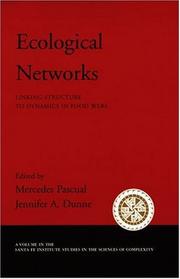
ISBN: 0199884919 1283113430 9786613113436 0199775052 0197700772 9780199775057 9781283113434 6613113433 0195188160 9780195188165 9780199884919 Year: 2023 Publisher: Oxford : Oxford University Press,
Abstract | Keywords | Export | Availability | Bookmark
 Loading...
Loading...Choose an application
- Reference Manager
- EndNote
- RefWorks (Direct export to RefWorks)
Food webs are one of the most useful, and challenging, objects of study in ecology. These networks of predator-prey interactions, conjured in Darwin's image of a "tangled bank," provide a paradigmatic example of complex adaptive systems. This book is based on a February 2004 Santa Fe Institute workshop. Its authors treat the ecology of predator-prey interactions, food web theory, structure and dynamics. The book explores the boundaries of what is known of the relationship between structure and dynamics in ecological networks and will define directions for future developments in this field.
Book
Year: 2022 Publisher: Wageningen : Wageningen Academic Publishers,
Abstract | Keywords | Export | Availability | Bookmark
 Loading...
Loading...Choose an application
- Reference Manager
- EndNote
- RefWorks (Direct export to RefWorks)
Sand flies are an ancient group of Diptera estimated to contain 1000 species. Approximately 70 of these transmit pathogens (viruses, bacteria and protists), which cause human and animal diseases. The most important are the Leishmania parasites, transmitted to humans and animals, during blood feeding by female sand flies, and which cause diseases that can be fatal or disfiguring. Sand flies are known to use volatile chemicals produced by plants to locate sugar meals, host odours to locate a blood meal, and chemicals from decaying vegetation and other sources to identify oviposition sites. In a limited number of cases, male sand flies also produce volatile chemicals (sex/aggregation pheromones) that are attractive to females and other males. The presence of sex/aggregation pheromones is well documented in Lutzomyia longipalpis sensu lato, the South American vector of Leishmania infantum, in which they were first identified 40 years ago. During this time, a range of behavioural and chemical methodologies have been applied to their study in the laboratory and the field. The presence of sex/aggregation pheromones has also been suggested in a small number of other New and Old-World vectors, but the evidence is incomplete, as it is either solely chemical, i.e. without supporting behavioural evidence or behavioural evidence is available, but there is no supporting chemical evidence. Within the Lu. longipalpis s.l. species complex, the sex/aggregation pheromones provide a taxonomic guide to the members of the complex. There are four different known chemical types (five members of the complex), and one of these, the most geographically widespread, has been synthesised in bulk quantity. The synthetic pheromone, co-located with insecticide, has been shown to significantly reduce numbers of sand flies, and leishmania infection in dogs, the reservoir of human infection, and could significantly impact the number of human cases.
Animal ecology. --- Habitat (Ecology) --- Food chains (Ecology)
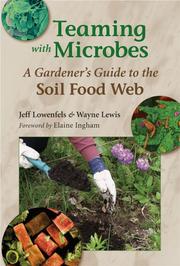
ISBN: 9780881927771 Year: 2009 Publisher: Portland Timber Press
Abstract | Keywords | Export | Availability | Bookmark
 Loading...
Loading...Choose an application
- Reference Manager
- EndNote
- RefWorks (Direct export to RefWorks)
Food chains (Ecology) --- Soil ecology --- Soil microbiology --- Soils
Book
ISBN: 1597268186 Year: 2010 Publisher: Washington : Island Press,
Abstract | Keywords | Export | Availability | Bookmark
 Loading...
Loading...Choose an application
- Reference Manager
- EndNote
- RefWorks (Direct export to RefWorks)
Scientist and author Cristina Eisenberg presents a fascinating and wide-ranging look at the dramatic ecological consequences of predator removal (and return) as she explores the concept of "trophic cascades" and the role of top predators in regulating ecosystems. She shows how and why animals such as wolves, sea otters, and sharks exert such a disproportionate influence on their environment, and considers how this notion can help provide practical solutions for restoring ecosystems.Trophic cascades are powerful stories about ecosystem processes--of predators and their prey, of what it takes to survive in a landscape, of the flow of nutrients. The Wolf's Tooth is the first book to focus on the vital connection between trophic cascades and biodiversity in a way that is accessible to a diverse readership.
Predation (Biology) --- Predatory animals --- Food chains (Ecology) --- Ecology.
Book
ISBN: 128357702X 9786613889478 0191646415 9780191646416 9781283577021 9780198566182 0198566182 9780198566199 0198566190 9780191774683 0191774685 0191646423 Year: 2012 Publisher: Oxford : OUP Oxford,
Abstract | Keywords | Export | Availability | Bookmark
 Loading...
Loading...Choose an application
- Reference Manager
- EndNote
- RefWorks (Direct export to RefWorks)
This novel book bridges the gap between the energetic and species approaches to studying food webs, addressing many important topics in ecology. Species, matter, and energy are common features of all ecological systems. Through the lens of complex adaptive systems thinking, the authors explore how the inextricable relationship between species, matter, and energy can explain how systems are structured and how they persist in real and model systems. Food webs are viewed as open anddynamic systems. The central theme of the book is that the basis of ecosystem persistence and stability rests on the
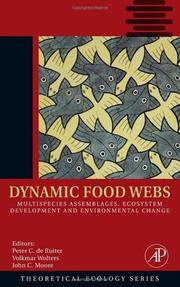
ISBN: 0120884585 9780120884582 9786610633265 1280633263 0080460941 9780080460949 9781280633263 6610633266 Year: 2005 Publisher: Amsterdam ; Boston : Academic Press,
Abstract | Keywords | Export | Availability | Bookmark
 Loading...
Loading...Choose an application
- Reference Manager
- EndNote
- RefWorks (Direct export to RefWorks)
Dynamic Food Webs challenges us to rethink what factors may determine ecological and evolutionary pathways of food web development. It touches upon the intriguing idea that trophic interactions drive patterns and dynamics at different levels of biological organization: dynamics in species composition, dynamics in population life-history parameters and abundances, and dynamics in individual growth, size and behavior. These dynamics are shown to be strongly interrelated governing food web structure and stability and the role of populations and communities play in ecosystem functioning.
Animal population --- plant population --- population dynamics --- Food chains --- Models --- Biodiversity --- ecosystems --- Biological competition --- Food chains (Ecology). --- Food chains (Ecology) --- Food webs (Ecology) --- Trophic ecology --- Animals --- Ecology --- Nutrient cycles --- Food
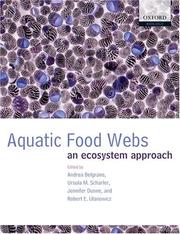
ISBN: 1281190411 0191524069 9786611190415 019856483X 1435620844 9780191524066 9780198564829 0198564821 9780198564836 9780191713828 0191713821 9781435620841 0198564821 Year: 2005 Publisher: Oxford : Oxford University Press,
Abstract | Keywords | Export | Availability | Bookmark
 Loading...
Loading...Choose an application
- Reference Manager
- EndNote
- RefWorks (Direct export to RefWorks)
'Aquatic Food Webs' provides a current synthesis of theoretical and empirical food web research. The textbook is suitable for graduate level students as well as professional researchers in community, ecosystem, and theoretical ecology, in aquatic ecology, and in conservation biology.
Aquatic ecology. --- Food chains (Ecology) --- Food webs (Ecology) --- Trophic ecology --- Animals --- Ecology --- Nutrient cycles --- Aquatic biology --- Food --- Aquatic ecology
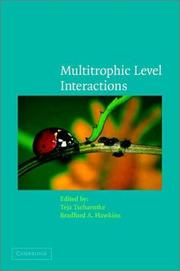
ISBN: 0521791103 9780521791106 0511067194 9780511067198 0511069324 9780511069321 0511170521 9780511170522 1280418176 9781280418174 9780511542190 0511542194 9780521084185 0521084180 1107129672 9786610418176 1139146793 0511060882 0511297580 Year: 2002 Publisher: Cambridge : Cambridge University Press,
Abstract | Keywords | Export | Availability | Bookmark
 Loading...
Loading...Choose an application
- Reference Manager
- EndNote
- RefWorks (Direct export to RefWorks)
The multitrophic level approach to ecology addresses the complexity of food webs much more realistically than the traditional focus on simple systems and interactions. Only in the last few decades have ecologists become interested in the nature of more complex systems including tritrophic interactions between plants, herbivores and natural enemies. Plants may directly influence the behaviour of their herbivores' natural enemies, ecological interactions between two species are often indirectly mediated by a third species, landscape structure directly affects local tritrophic interactions and below-ground food webs are vital to above-ground organisms. The relative importance of top-down effects (control by predators) and bottom-up effects (control by resources) must also be determined. These interactions are explored in this exciting volume by expert researchers from a variety of ecological fields. This book provides a much-needed synthesis of multitrophic level interactions and serves as a guide for future research for ecologists of all descriptions.
Multitrophic interactions (Ecology). --- Environmental Sciences and Forestry. Environmental Management --- Environmental Protection. --- ecosystems --- Animal population --- plant population --- Biological competition --- Multitrophic interactions (Ecology) --- Interactions, Multitrophic (Ecology) --- Food chains (Ecology)
Book
ISBN: 9781620810538 1620810530 9781613243770 1613243774 Year: 2012 Publisher: New York
Abstract | Keywords | Export | Availability | Bookmark
 Loading...
Loading...Choose an application
- Reference Manager
- EndNote
- RefWorks (Direct export to RefWorks)
Environmental toxicology. --- Food chains (Ecology) --- Food webs (Ecology) --- Trophic ecology --- Animals --- Ecology --- Nutrient cycles --- Ecotoxicology --- Pollutants --- Pollution --- Environmental health --- Toxicology --- Food

ISBN: 0691074879 0691074860 140084729X 1299051472 9781400847297 9780691074870 9780691074863 9780691074870 Year: 2002 Volume: 34 Publisher: Princeton, N.J. : Princeton University Press,
Abstract | Keywords | Export | Availability | Bookmark
 Loading...
Loading...Choose an application
- Reference Manager
- EndNote
- RefWorks (Direct export to RefWorks)
Most of the earth's terrestrial species live in the soil. These organisms, which include many thousands of species of fungi and nematodes, shape aboveground plant and animal life as well as our climate and atmosphere. Indeed, all terrestrial ecosystems consist of interdependent aboveground and belowground compartments. Despite this, aboveground and belowground ecology have been conducted largely in isolation. This book represents the first major synthesis to focus explicitly on the connections between aboveground and belowground subsystems--and their importance for community structure and ecosystem functioning. David Wardle integrates a vast body of literature from numerous fields--including population ecology, ecosystem ecology, ecophysiology, ecological theory, soil science, and global-change biology--to explain the key conceptual issues relating to how aboveground and belowground communities affect one another and the processes that each component carries out. He then applies these concepts to a host of critical questions, including the regulation and function of biodiversity as well as the consequences of human-induced global change in the form of biological invasions, extinctions, atmospheric carbon-dioxide enrichment, nitrogen deposition, land-use change, and global warming. Through ambitious theoretical synthesis and a tremendous range of examples, Wardle shows that the key biotic drivers of community and ecosystem properties involve linkages between aboveground and belowground food webs, biotic interaction, the spatial and temporal dynamics of component organisms, and, ultimately, the ecophysiological traits of those organisms that emerge as ecological drivers. His conclusions will propel theoretical and empirical work throughout ecology.
General ecology and biosociology --- Food chains (Ecology) --- Soil ecology. --- Environmental Sciences and Forestry. Ecology --- Ecology (General) --- Food chains (Ecology). --- Ecology (General). --- Food webs (Ecology) --- Edaphology --- Animals --- Biological productivity --- Ecology --- Niche (Ecology) --- Nutrient cycles --- Soils --- Roots (Botany) --- Food --- Environmental aspects --- Trophic ecology
| Listing 1 - 10 of 24 | << page >> |
Sort by
|

 Search
Search Feedback
Feedback About
About Help
Help News
News